ABSTRACT
Rice is the main staple food crop and is cultivated on about half of the net sown area in Myanmar. Most farmers depended on rain-fed agriculture in Myanmar. The objectives of the paper were to study the socio-economic characteristics of selected farmers and analyze the cost and returns of monsoon rice production across different varieties for both domestic and export markets in the study area. The survey was conducted in June 2024. Primary data were collected from 180 paddy farmers from the selected townships of Nay Pyi Taw Union Territory, by using the purposive sampling method. Descriptive analysis and the cost and return analysis were used to fulfill the objectives of the study. Sample farmers grew ten domestic marketed rice varieties (DMM) and seven export-marketed rice varieties (EMM). Sinnthukha was the most popular variety in DMM, and Thai Hnankauak was the most popular variety in EMM. The benefit-cost ratios were 2.15 in EMM and 1.99 in DMM. In terms of profit, the selected farmers earned US$1.15 from EMM and US$0.99 from DMM for every unit of cash invested. EMM rice farmers received lower prices for their rice compared to DMM farmers, but their higher yields resulted in greater overall profits. EMM rice production was more economically attractive than DMM rice production for farmers. The profitability of rice farmers is essential for improving their livelihoods. Therefore, the increased rice production should be encouraged, especially by producing more using the export-marketed rice varieties (EMM) to get more profit. And the public sector should encourage the cultivation of export-marketed rice varieties which has domestic and international market demand for increasing foreign currency income earning.
Keywords: Benefit-cost ratio, domestic marketed rice varieties, export marketed rice varieties, monsoon rice production
INTRODUCTION
Rice is the most essential food crop of Myanmar. It remains a strategic sector in terms of its continuing considerable contribution to Gross Domestic Product (GDP), income, and employment generation. Based on the estimated total population of 55.77 million in 2022-2023, about 13% (7.20 million) are engaged in agriculture as farmers. On the supply side, rice is the principal crop, cultivated on 6.32 million hectares, which accounts for 47.09% of the net-sown area. Rice is the primary source of energy for the Myanmar people, as it contributes approximately 73% and 80% of the total daily dietary energy requirement in urban and rural households, respectively (CSO, 2023).
Despite consistently aiming to increase growth in rice production over the years, Myanmar’s performance in generating an exportable surplus has remained erratic, both at the Union level and across the different regions and states. Consequently, it is important to not only focus on domestic price stability but also to examine the price gaps between domestic wholesale prices and the prices at harvest-time on the one hand, and between domestic wholesale prices and international prices of different rice varieties on the other hand. In Myanmar, paddy production has been increased by using high quality paddy varieties, use of appropriate cultural practices following the rice eco-system, timely irrigation in irrigated areas, expansion of modern farm machinery, educating farmers to use fertilizers and pesticides in a timely and proportionate manner, and extension on agricultural education since 2011 (Wong and Wai, 2013).
In 2022-2023, major varieties of paddy are Sinnthukha, Manawthukha, Ayeyarmin, Pawsanyin, Sinakayi-3, Meedone, Shwewarrtun, Hnannkarr, Sinthwelatt, Yatanartoe, Theehtetyin, 90-Days, Pakhanshwewar, Shwethweyin, Supernankauk, Hmawbi-2 and Yezinlonethwe (MOALI, 2023). In Nay Pyi Taw, the rice varieties that are mostly sown are Manawthukah, Sinthukha, 90-Days and Thai hnankauak varieties. Farmers have grown the first two varieties as monsoon crops and the others as summer crops. Manawthukah and Sinthukha varieties are highly preferred for their eating quality, high yield, and marketability in domestic market, whereas 90-Days and Thai Hnankauak varieties are in the Emata group, which is the main exported rice group (DOA, 2024).
In Myanmar, the major problem in rice sector is marketing management along the value chain. In both the domestic and export rice industry, price uncertainty can decrease market efficiency, response, and productivity. The performance of participants along the rice value chain can influence the marketing efficiency. After the rice market liberalization, there was no prominent improvement in Myanmar’s rice export by the private sector. While the world rice price market fluctuated, domestic rice production costs in Myanmar increased year by year. Then, the price of high-quality rice was higher than that of low-quality rice in the world market. Therefore, a significant price gap has existed between high-quality and low-quality rice. When the current international rice trade is highly competitive, Myanmar’s rice production depends on economic efficiency (World Bank, 2019).
Based on this concept, the paper aims to analyze the performances of selected rice farmers in the study area. The specific objectives of this paper were:
- To study the socio-economic characteristics of the selected monsoon rice farmers in the study area; and
- To analyse the cost and return of monsoon rice production of selected farmers, focusing on different varieties for domestic and export markets.
METHODOLOGY
General description of the study area
Nay Pyi Taw (NPT) is located between the Bago Yoma and Shan Yoma mountain ranges, and lies approximately 1.9 miles West of Pyinmana Township and 200 miles North of Yangon. It is also at the Southern tip of the central dry zone. It stands at 19• 45′ North latitude and 96• 6′ East longitude and has an area of 7,054.37 km2. It is situated at 400 ft elevation above the sea level. NPT was selected based on the following reasons that it is the capital city of Myanmar, high rice yields and improved productivity in recent years, the presence of model farms and pilot projects that adopt different rice varieties, proximity to research institutions like Yezin Agricultural University and Department of Agricultural Research, a unique market dynamic where farmers may be growing both domestic-preferred and export-grade varieties.
Nay Pyi Taw consists of eight administrative townships: Pyinmana, Lewe, Tatkon, Ottarathiri, Dekkhinathiri, Pobbathiri, Zabuthiri and Zeyarthiri Townships (DOP, 2014). Among the eight townships in Nay Pyi Taw, Lewe has the largest sown area with highest production of rice followed by Tatkon, Pyinmana, Zeyarthiri, Pobbathiri, Ottarathiri, Dekkhinathiri and Zabuthiri. In Lewe Township, the sown area was 25,314 ha, with an average yield of 4.18 ton per ha, resulting in a production of 105,805 ton (MOALI, 2023). This paper selected the study areas based on the top in rice sown area and production. Therefore, Pyinmana, Lewe, Tatkon, Pobbathiri and Zeyarthiri Townships were purposively selected as the study areas. In this study, the total of 180 paddy farmers from (18) village tracts were selected from NPT. The sample included farmers who cultivated both domestic and exported-rice varieties. This study purposively included farmers growing export-oriented rice varieties alongside those cultivating for the domestic market. The selected townships are known for diverse rice cultivation practices, including varieties preferred by exporters. This ensures that the sample provided meaningful insights into the profitability and practices of export rice producers, even though it may not cover all major rice-exporting regions of Myanmar.
Method of analysis
This paper analyzed the relationship between the costs of rice production, revenues, benefit-cost ratios and rice varieties. It also focused on selected farmers who grew rice for domestic and export markets during monsoon season in 2023. According to the primary data, all 180 selected farmers were involved in the production of monsoon rice. The selected farmers grew the varieties such as Sinnthukha, Manawthukha, Ayeyarmin, Machando, Shwewahwin, Shwewahhmwe, Thukha-1, Basmati, Ayeyar Padaedar, Paw San, Thai Hnankauak, Byauttun, GW-11, Byautthukha, Yadanartoe, Palethwe and 90-Days in monsoon season. The most popular rice varieties in domestic market were Sinnthukha, Manawthukha, Ayeyarmin, Machando, Shwewahwin, Shwewahhmwe, Thukha-1, Basmati, Ayeyar Padaedar and Paw San. The most popular rice varieties in export market were Thai Hnankauak, Byauttun, GW-11, Byautthukha, Yadanartoe, Palethwe and 90-Days according to the survey data, publications from the DOA and other literature.
The grouping of selected farmers was allocated based on the number of growing varieties in monsoon season. The first group included the 116 farmers who grew domestic marketed rice varieties. The 101 farmers from 116 farmers grew only one domestic marketed rice variety and other 15 farmers grew one each type of domestic marketed and export marketed rice varieties. So, this group was defined as the farmers group who grew domestic marketed rice varieties in monsoon season (DMM). And, the second group included the 90 farmers who grew export marketed rice varieties. The 75 farmers from 90 farmers grew only one export-marketed rice variety, and the other 15 farmers grew one of each type of export-marketed and domestic-marketed rice varieties. So, this group was defined as the farmer's group who grew export-marketed rice varieties in the monsoon season (EMM). Therefore, the total number of 206 farmers was based on the number of growing varieties in the monsoon season. The detailed description is described in Table 1.
Both quantitative and qualitative data were first entered into the Microsoft Excel program and STATA 15 statistical software. The analytical techniques, which included descriptive statistics such as frequency, percentage, etc. The cost and return analysis with related methods were calculated by using the Microsoft Excel program to fulfill the paper objectives.
Cost and return analysis
Enterprise budgeting was the first tool used in economic analyses. An enterprise budget was a physical and financial plan for raising and selling a particular crop commodity. Enterprise budget enables the evaluation of the cost and return of the production process. Hired labour costs were valued by market wage rates and man days used in all farming practices. To estimate the gross return for each crop, the average yield and average price were used. Benefit-cost ratio was used as a profitability measure for each crop enterprise, computing a profitability measure for each crop enterprise, computing the total gross margin or return above variable cost, and return above cash costs. Input quantities and values used in the production process (costs) and output quantities and values (benefits) are the basic data required for budgets. The purpose of enterprise budgeting was to show the difference in net benefits under several resource’ situations in such a way as to help one make management decisions (Olson, 2009).
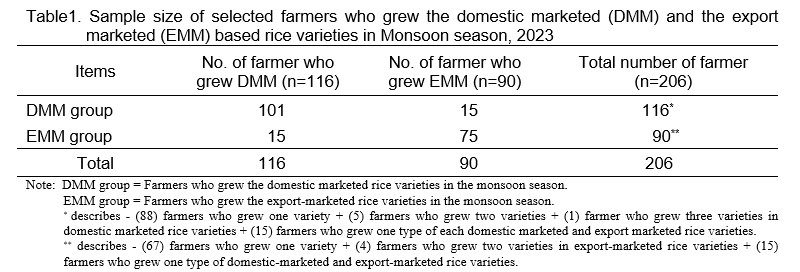
The cost and return analysis was used to assess the profitability of different varieties of rice production in the study area on an average basis. In this analysis, the variable cost of rice production was divided into four categories as follows: (1) Material input cost, (2) Hired labor cost, (3) Family labor cost, and (4) Interest on cash cost. These measurements were expressed with equations as:
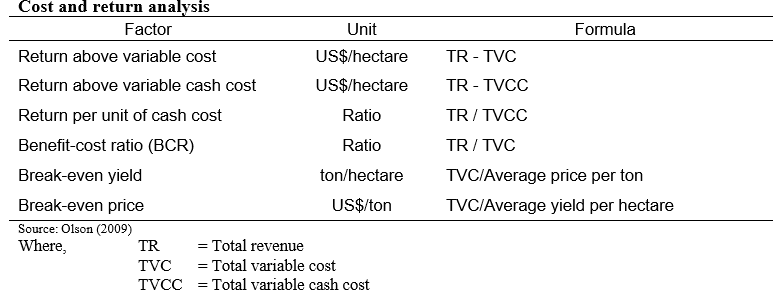
Results and discussion
This chapter described the households’ socio-economic characteristics and the cost and return analysis of monsoon rice production of selected farmers in the study area according to the group of farmers.
Description of households’ socio-economic characteristics
Age, education levels, gender, farming experience, household size, household farm labor, and farm size of selected farmers were principally described as vital socio-economic characteristics of selected farmers in the study area.
Age distribution of selected monsoon rice farmers in the study area
The average age of selected farmers was 55 years, ranging from 27 years to 85 years for DMM and 52 years, ranging from 20 years to 77 years for EMM in Table 2. The t-test revealed no significant difference in the average age between the two groups. The DMM farmers had an average farming experience of 33 years, ranging from 2 years to 70 years, while the EMM farmers had 30 years, ranging from 3 years to 60 years. The t-test revealed no significant difference in the average age between the two groups.
But, they spend almost half of their lives in farming when comparing their average age and average farm experience. So, they had more production experience and potential for decision-making in rice production. The average farm size owned by the DMM farmers was 2.92 ha, ranging from 0.40 ha to 16.19 ha, while the EMM farmers owned an average of 2.60 ha, with the same range. The t-test showed that there was no significant difference in the average area of farm size between two groups.
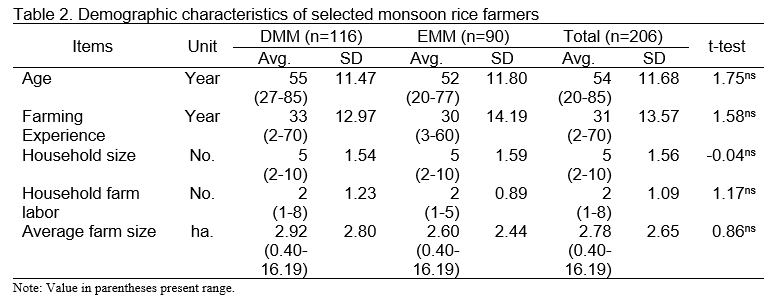
Gender and education levels of selected monsoon rice farmers in the study area
Figure 1 displays the education levels of selected farmers. The selected farmers’ education levels were distributed into six categories. Monastery education referred to monastery schooling although they could read and write, primary level referred to formal education up to five years, middle level referred to formal schooling up to nine years, high school level referred to formal education up to 11 years and graduate level mentioned to those who was attending the university and received a bachelor from university. The majority of selected farmers had a primary education level in 36.21% of DMM and 33.33% of EMM, respectively.
The study results that the majority of selected farmers were male, which were 67.24% of the DMM farmers and 74.44% of the EMM farmers. 32.76% of the DMM and 25.56% of the EMM farmers were female, as presented in Figure 2. Therefore, female farmers were generally very rare, and male farmers were common in agricultural farming activities. It showed that male farmers dominate monsoon rice production.
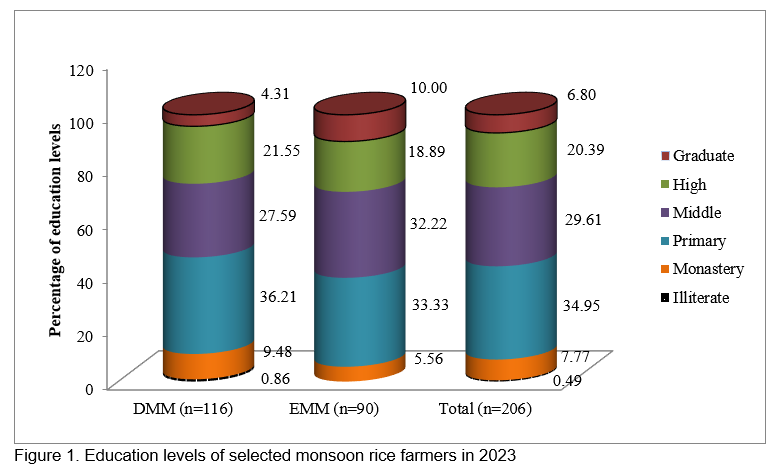
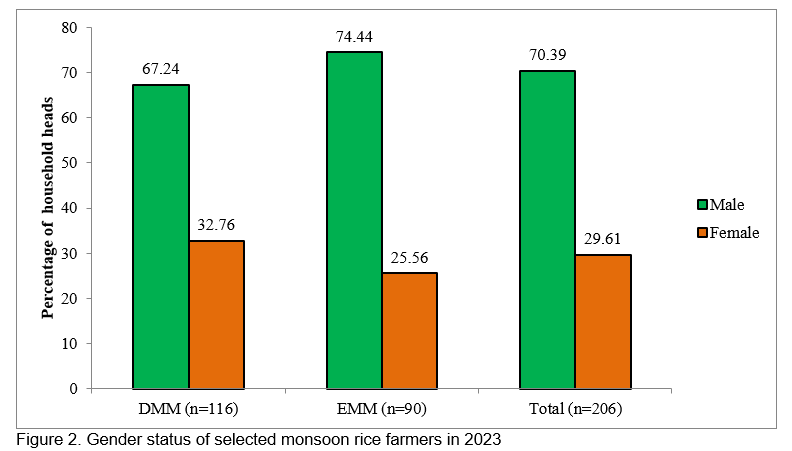
Rice varieties diversification by selected monsoon rice farmers in the study area
The farm households selected and grew the rice varieties based on the following reasons such as getting higher yield than other varieties, getting higher quality than other varieties, getting stronger market demand than other varieties, resistance to pest and diseases than other varieties, higher weight than other varieties and other reasons (cultivating like farmers near the farm).
Sinnthukha was the most popular variety in domestic marketed rice varieties, with 44.83%, and Thai Hnankauak was the most popular variety in export marketed rice varieties, with 47.78%, among growing varieties by the selected monsoon rice farmers (Table 3). Therefore, this study found that most farmers commonly cultivated Sinnthukha and Thai Hnankauak varieties because these two varieties yielded higher than other varieties.
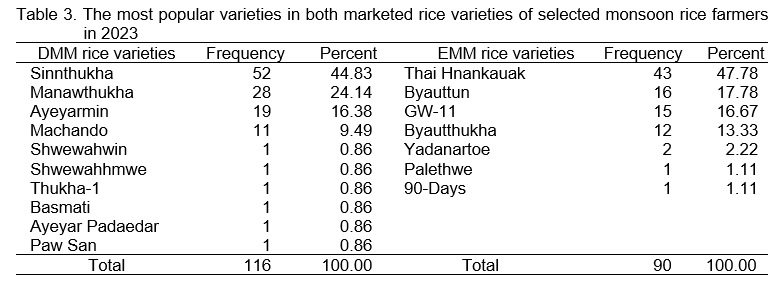
Information of rice production and marketing by selected monsoon rice farmers in the study area
The percentage share of average production clearly illustrated in Table 4 for DMM and EMM farmers. The largest proportion of average production was used by 55.86% of DMM and 85.05% of EMM farmers in marketed surplus. The home consumption was the second largest proportion used for two groups of farmers, 41.48% of DMM and 13.22% of EMM farmers. Home consumption average is different between DMM and EMM due to cultural preferences, cooking quality and flavour, farmers that cultivated domestic rice type frequently save a larger amount of their production for domestic use. In contracts, exported-rice varieties are typically grown for commercial purposes and farmers tend to sell a higher proportion to meet demand, resulting in lower quantities reserved for home use. Additionally, some export varieties may not align with local taste, preferences, further reducing their home consumption.
The small portion share was found in reserved seed for two groups, 2.66% of DMM and 1.73% of EMM farmers. According to this table, the marketed surpluses of EMM farmers were obviously higher than that of DMM farmers. Therefore, the export marketed rice varieties were the variety which has the most supply among the monsoon rice farmers.
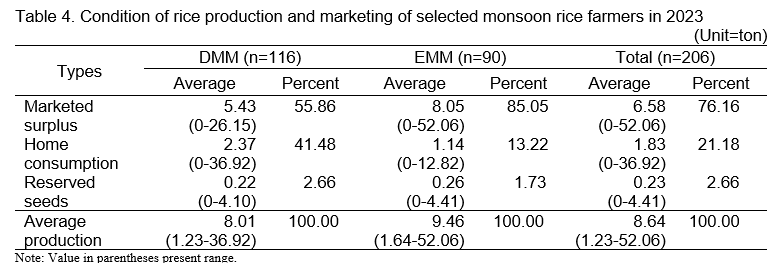
Material inputs costs of rice production by selected monsoon rice farmers in the study area
The materials costs used by monsoon rice farmers included seed, FYM, T-super, urea, compound, potash, gypsum, herbicides, pesticides, fungicides, foliar (Among the foliar fertilizers are compost and fish emulsion. In order to practice sustainable agriculture, some rice farmers in the study area were now employing natural fertilizers instead of chemical ones.), and diesel in rice production. The total materials costs for DMM rice varieties production were US$419.31/ha; the EMM rice varieties production were US$417.25/ha. The highest materials costs of the compound were about US$119.13/ha in DMM, US$116.70/ha in EMM. The second highest material costs of urea was US$106.77/ha in DMM and US$98.64 /ha in EMM.
The cost of seeds was about US$89.54/ha in DMM rice varieties production and US$92.14/ha in EMM rice varieties production. The total cost per hectare of DMM rice varieties production was slightly higher than that of EMM rice varieties production. But this study found that there was no significant difference between the two groups for monsoon rice production. The detailed description of this cost is described in Table 5.
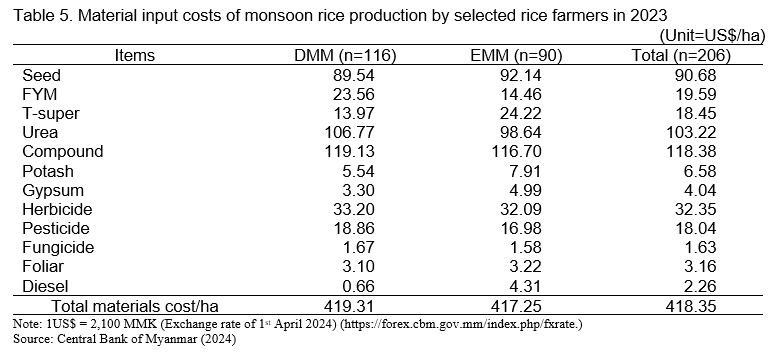
Total labor costs of rice production by selected monsoon rice farmers in the study area
The total labor costs for DMM rice varieties production were US$620.89/ha, with US$134.43/ha of the family labor costs and US$486.46/ha of the hired labor costs. The total labor costs for the EMM rice varieties production were US$541.57/ha, with US$98.62/ha of the family labor costs and US$442.95/ha of the hired labor costs.
The most significant amount of combined harvester costs was US$129.70/ha in DMM and US$126.22/ha in EMM among the costs of rice production. The total cost of DMM rice variety production was higher than that of EMM. Therefore, it was found that the cost of DMM in monsoon rice production was relatively high, as presented in Table 6. In this study, the costs of sowing, threshing, and drying for export-marketed rice varieties were found to be comparatively lower than those for domestic-marketed rice varieties. This may be due to the fact that many farmers growing export-marketed rice varieties use more efficient or mechanized practices, benefit from contract farming support, or have access to improved infrastructure and input packages.
In contrast, some farmers producing domestic varieties may rely on traditional methods that are more labor-intensive and less cost-efficient. However, transportation costs for export rice remain higher due to longer distances to milling or export centers and stricter post-harvest handling requirements. In this analysis, the study found that irrigation costs for domestic-marketed rice varieties were higher than those for export-marketed rice varieties. This could be due to differences in water use practices or field locations. Farmers growing domestic varieties may rely more on manual or traditional irrigation methods, which can be labor-intensive and less efficient.
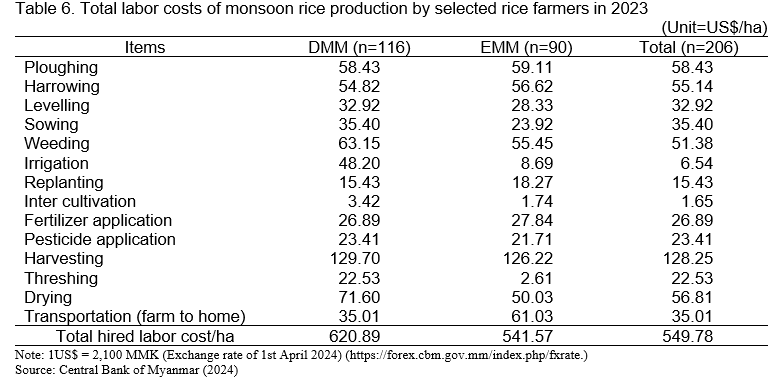
Economic analysis of rice production by selected monsoon rice farmers in the study area
The cost and return analysis of monsoon rice production was determined using enterprise budgeting. An enterprise budget is an estimate of the costs and returns associated with the production of a product or products, referred to as an enterprise (Smith et al., 2013). The different costs of rice production of the selected farmers in the study area were presented in Table 7.
Total revenue was computed by multiplying the yield and price received by selected farmers. Total revenue was US$2,023.64/ha in DMM, and US$2,040.45/ha in EMM. The total variable costs of selected farmers were US$1,067.27/ha in DMM and US$985.93/ha in EMM for monsoon rice production. The return above variable cost (or) gross margin was US$956.37/ha in DMM and US$1,054.52/ha in EMM. Benefit-cost ratios were 1.99 in DMM and 2.15 in EMM.
The findings indicated that EMM rice variety production in the study area was profitable because farmers received US$1.15 in EMM and US$0.99 in DMM for every unit of cash expense invested in rice production. The break-even yield was the yield that could cover the total variable cost at the current rice price, and the break-even price was the price that could cover the total variable cost at the current rice production. Yield and market price of rice production by selected farmers were 4.31 ton/ha and US$472.34/ton in DMM and 4.92 ton/ha and US$416.67/ton in EMM, as presented in Table 7.
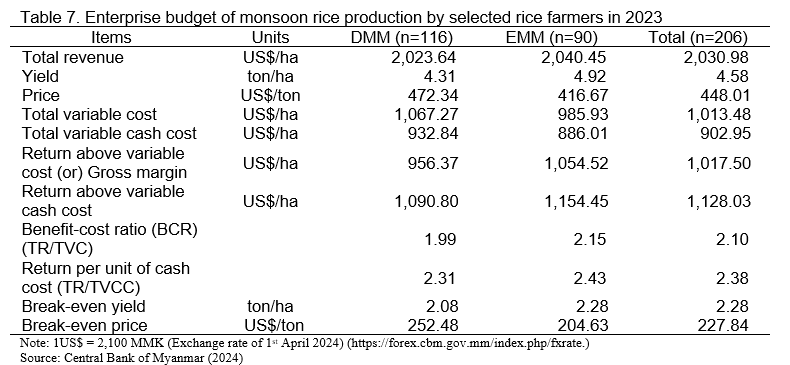
The break-even yield and break-even price of rice production by selected farmers were 2.08 ton/ha and US$252.48/ton in DMM and 2.28 ton/ha and US$204.63/ton in EMM. These findings indicated that even if the selected farmer’s yield covered the total variable cost at the current rice price. Therefore, rice production of the selected farmers in the study area was in a profitable position.
The enterprise budget of monsoon rice production by selected farmers was described in Table 7. This table shows that the average total revenue from rice production was US$2,030.98/ha. The yield and market price of rice production by selected farmers were 4.58 ton/ha and US$448.01/ton.
The total variable costs of rice production were US$1,013.48/ha, and the total variable cash costs were US$902.95/ha in monsoon rice production by selected farmers. The return above variable cost (or) gross margin was US$1,017.50/ha. The return above variable cash cost was US$1,128.03/ha of rice production by selected farmers as presented in Table 7. Return per unit of capital invested and return per unit of cash expended in the study area were presented in this table. A benefit-cost ratio of 2.10 was achieved in monsoon rice production. The findings indicated that monsoon rice production in the study area was profitable because farmers get back US$1.10 by average if they invest a unit cash expense in rice production. The break-even yield and break-even price of monsoon rice production by selected farmers were 2.28 ton/ha and US$227.84/ton.
CONCLUSION AND RECOMMENDATIONS
The most popular rice variety in the study area was Sinnthukha in the domestic marketed rice varieties (DMM) and Thai Hnankauak in the export marketed rice varieties (EMM) because these two varieties were getting higher yield than other varieties. Although domestic marketed rice varieties were priced higher than export-marketed ones, this study found that export-marketed rice varieties yielded higher yields and made higher profits.. The total variable cost was higher in DMM rice production than in EMM rice production.
On gross margin, the selected farmers who grew the EMM had higher margin than DMM rice farmers. The benefit-cost ratios were 2.15 in EMM rice production and 1.99 in DMM rice production. In terms of profit, the selected farmers earned US$1.15 from EMM rice production and US$0.99 from DMM rice production for a unit cash invested. The finding of this study implied the gap of yield between two groups. EMM rice farmers received lower prices for their rice compared to DMM farmers, their higher yields resulted in greater overall profits. EMM rice production was economically more attractive than DMM rice production for farmers. So, the selected farmers who grew EMM had higher profit than DMM rice farmers.
The profitability of rice farmers is essential for improving their livelihoods. Therefore, the increased rice production should be encouraged especially more produce using the export marketed rice varieties (EMM) for getting more profit. The farmers should cultivate more with export-marketed rice varieties that have a higher yield if they have enough for home consumption. To improve the agricultural sector, it is necessary to formulate the relevant plan, strategies, policies, instructions, and procedures according to the laws and regulations. The public sector should encourage the cultivation of export-marketed rice varieties which have domestic and international market demand for increasing foreign currency income.
This research mainly focused on the costs and return of rice farmers in monsoon rice production based on domestic and export-marketed rice varieties grown in Nay Pyi Taw. Although the current statistics are not sufficient and inadequate for national level, it is recommended that this research will provide useful references to future research on the analysis of rice production at a national level.
REFERENCES
Central Statistical Organization, (2023). Statistical Yearbook 2022. Ministry of National Planning and Economic Development. Nay Pyi Taw, Myanmar
Central Bank of Myanmar, (2024), Reference Exchange Rate History, Foreign Exchange Rates as 1th April 2024. https://forex.cbm.gov.mm/index.php/fxrate.
Department of Population (2014). The 2014 Myanmar Population and Housing Census: The Union Report. The Republic of the Union of Myanmar, Census Report Volume 2.
Department of Agriculture, (2024). Annual Report of Department of Agriculture, Nay Pyi Taw Council. Ministry of Agriculture, Livestock and Irrigation. Nay Pyi Taw. Myanmar
Ministry of Agriculture and Irrigation. (2023). Recommendation for adaptable rice varieties in State & Region. Unpublished document. Nay Pyi Taw. Myanmar
Olson, K. (2009). “Farm management - Principles and Strategies. The Text Book of Farm Management: Principles and Strategies”.
Smith, J., McCorkle, D., Outlaw, J., and Daniel Hanselka. (2013). Making Decisions with Enterprise Budgets. Retrieved from AgriLife Extension. http://agrilife. org/agecoext/files/2013/10/rm3-10.pdf
Wong, L. and Wai, Eh. M. A. (2013). Rapid Value Chain Assessment: Structure and Dynamics of the Value Chain in Myanmar. Strategic agricultural sector and food security diagnostic for Myanmar. Background paper No.6. Michigan State University and Myanmar Research and Development Institute: 1-46.
World Bank. (2019). Myanmar Rice and Pluses: Farm Production Economics and Value Chain Dynamics. Working Paper, Report Number: 138214. World Bank, Washington, DC: World Bank.
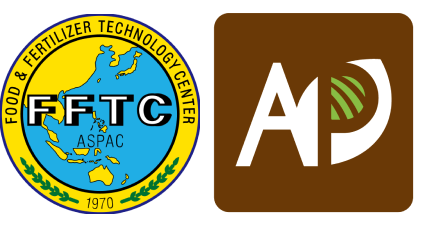

Profitability of Different Rice Varieties for Domestic and Export Markets: A Case Study in Nay Pyi Taw Union Territory, Myanmar
ABSTRACT
Rice is the main staple food crop and is cultivated on about half of the net sown area in Myanmar. Most farmers depended on rain-fed agriculture in Myanmar. The objectives of the paper were to study the socio-economic characteristics of selected farmers and analyze the cost and returns of monsoon rice production across different varieties for both domestic and export markets in the study area. The survey was conducted in June 2024. Primary data were collected from 180 paddy farmers from the selected townships of Nay Pyi Taw Union Territory, by using the purposive sampling method. Descriptive analysis and the cost and return analysis were used to fulfill the objectives of the study. Sample farmers grew ten domestic marketed rice varieties (DMM) and seven export-marketed rice varieties (EMM). Sinnthukha was the most popular variety in DMM, and Thai Hnankauak was the most popular variety in EMM. The benefit-cost ratios were 2.15 in EMM and 1.99 in DMM. In terms of profit, the selected farmers earned US$1.15 from EMM and US$0.99 from DMM for every unit of cash invested. EMM rice farmers received lower prices for their rice compared to DMM farmers, but their higher yields resulted in greater overall profits. EMM rice production was more economically attractive than DMM rice production for farmers. The profitability of rice farmers is essential for improving their livelihoods. Therefore, the increased rice production should be encouraged, especially by producing more using the export-marketed rice varieties (EMM) to get more profit. And the public sector should encourage the cultivation of export-marketed rice varieties which has domestic and international market demand for increasing foreign currency income earning.
Keywords: Benefit-cost ratio, domestic marketed rice varieties, export marketed rice varieties, monsoon rice production
INTRODUCTION
Rice is the most essential food crop of Myanmar. It remains a strategic sector in terms of its continuing considerable contribution to Gross Domestic Product (GDP), income, and employment generation. Based on the estimated total population of 55.77 million in 2022-2023, about 13% (7.20 million) are engaged in agriculture as farmers. On the supply side, rice is the principal crop, cultivated on 6.32 million hectares, which accounts for 47.09% of the net-sown area. Rice is the primary source of energy for the Myanmar people, as it contributes approximately 73% and 80% of the total daily dietary energy requirement in urban and rural households, respectively (CSO, 2023).
Despite consistently aiming to increase growth in rice production over the years, Myanmar’s performance in generating an exportable surplus has remained erratic, both at the Union level and across the different regions and states. Consequently, it is important to not only focus on domestic price stability but also to examine the price gaps between domestic wholesale prices and the prices at harvest-time on the one hand, and between domestic wholesale prices and international prices of different rice varieties on the other hand. In Myanmar, paddy production has been increased by using high quality paddy varieties, use of appropriate cultural practices following the rice eco-system, timely irrigation in irrigated areas, expansion of modern farm machinery, educating farmers to use fertilizers and pesticides in a timely and proportionate manner, and extension on agricultural education since 2011 (Wong and Wai, 2013).
In 2022-2023, major varieties of paddy are Sinnthukha, Manawthukha, Ayeyarmin, Pawsanyin, Sinakayi-3, Meedone, Shwewarrtun, Hnannkarr, Sinthwelatt, Yatanartoe, Theehtetyin, 90-Days, Pakhanshwewar, Shwethweyin, Supernankauk, Hmawbi-2 and Yezinlonethwe (MOALI, 2023). In Nay Pyi Taw, the rice varieties that are mostly sown are Manawthukah, Sinthukha, 90-Days and Thai hnankauak varieties. Farmers have grown the first two varieties as monsoon crops and the others as summer crops. Manawthukah and Sinthukha varieties are highly preferred for their eating quality, high yield, and marketability in domestic market, whereas 90-Days and Thai Hnankauak varieties are in the Emata group, which is the main exported rice group (DOA, 2024).
In Myanmar, the major problem in rice sector is marketing management along the value chain. In both the domestic and export rice industry, price uncertainty can decrease market efficiency, response, and productivity. The performance of participants along the rice value chain can influence the marketing efficiency. After the rice market liberalization, there was no prominent improvement in Myanmar’s rice export by the private sector. While the world rice price market fluctuated, domestic rice production costs in Myanmar increased year by year. Then, the price of high-quality rice was higher than that of low-quality rice in the world market. Therefore, a significant price gap has existed between high-quality and low-quality rice. When the current international rice trade is highly competitive, Myanmar’s rice production depends on economic efficiency (World Bank, 2019).
Based on this concept, the paper aims to analyze the performances of selected rice farmers in the study area. The specific objectives of this paper were:
METHODOLOGY
General description of the study area
Nay Pyi Taw (NPT) is located between the Bago Yoma and Shan Yoma mountain ranges, and lies approximately 1.9 miles West of Pyinmana Township and 200 miles North of Yangon. It is also at the Southern tip of the central dry zone. It stands at 19• 45′ North latitude and 96• 6′ East longitude and has an area of 7,054.37 km2. It is situated at 400 ft elevation above the sea level. NPT was selected based on the following reasons that it is the capital city of Myanmar, high rice yields and improved productivity in recent years, the presence of model farms and pilot projects that adopt different rice varieties, proximity to research institutions like Yezin Agricultural University and Department of Agricultural Research, a unique market dynamic where farmers may be growing both domestic-preferred and export-grade varieties.
Nay Pyi Taw consists of eight administrative townships: Pyinmana, Lewe, Tatkon, Ottarathiri, Dekkhinathiri, Pobbathiri, Zabuthiri and Zeyarthiri Townships (DOP, 2014). Among the eight townships in Nay Pyi Taw, Lewe has the largest sown area with highest production of rice followed by Tatkon, Pyinmana, Zeyarthiri, Pobbathiri, Ottarathiri, Dekkhinathiri and Zabuthiri. In Lewe Township, the sown area was 25,314 ha, with an average yield of 4.18 ton per ha, resulting in a production of 105,805 ton (MOALI, 2023). This paper selected the study areas based on the top in rice sown area and production. Therefore, Pyinmana, Lewe, Tatkon, Pobbathiri and Zeyarthiri Townships were purposively selected as the study areas. In this study, the total of 180 paddy farmers from (18) village tracts were selected from NPT. The sample included farmers who cultivated both domestic and exported-rice varieties. This study purposively included farmers growing export-oriented rice varieties alongside those cultivating for the domestic market. The selected townships are known for diverse rice cultivation practices, including varieties preferred by exporters. This ensures that the sample provided meaningful insights into the profitability and practices of export rice producers, even though it may not cover all major rice-exporting regions of Myanmar.
Method of analysis
This paper analyzed the relationship between the costs of rice production, revenues, benefit-cost ratios and rice varieties. It also focused on selected farmers who grew rice for domestic and export markets during monsoon season in 2023. According to the primary data, all 180 selected farmers were involved in the production of monsoon rice. The selected farmers grew the varieties such as Sinnthukha, Manawthukha, Ayeyarmin, Machando, Shwewahwin, Shwewahhmwe, Thukha-1, Basmati, Ayeyar Padaedar, Paw San, Thai Hnankauak, Byauttun, GW-11, Byautthukha, Yadanartoe, Palethwe and 90-Days in monsoon season. The most popular rice varieties in domestic market were Sinnthukha, Manawthukha, Ayeyarmin, Machando, Shwewahwin, Shwewahhmwe, Thukha-1, Basmati, Ayeyar Padaedar and Paw San. The most popular rice varieties in export market were Thai Hnankauak, Byauttun, GW-11, Byautthukha, Yadanartoe, Palethwe and 90-Days according to the survey data, publications from the DOA and other literature.
The grouping of selected farmers was allocated based on the number of growing varieties in monsoon season. The first group included the 116 farmers who grew domestic marketed rice varieties. The 101 farmers from 116 farmers grew only one domestic marketed rice variety and other 15 farmers grew one each type of domestic marketed and export marketed rice varieties. So, this group was defined as the farmers group who grew domestic marketed rice varieties in monsoon season (DMM). And, the second group included the 90 farmers who grew export marketed rice varieties. The 75 farmers from 90 farmers grew only one export-marketed rice variety, and the other 15 farmers grew one of each type of export-marketed and domestic-marketed rice varieties. So, this group was defined as the farmer's group who grew export-marketed rice varieties in the monsoon season (EMM). Therefore, the total number of 206 farmers was based on the number of growing varieties in the monsoon season. The detailed description is described in Table 1.
Both quantitative and qualitative data were first entered into the Microsoft Excel program and STATA 15 statistical software. The analytical techniques, which included descriptive statistics such as frequency, percentage, etc. The cost and return analysis with related methods were calculated by using the Microsoft Excel program to fulfill the paper objectives.
Cost and return analysis
Enterprise budgeting was the first tool used in economic analyses. An enterprise budget was a physical and financial plan for raising and selling a particular crop commodity. Enterprise budget enables the evaluation of the cost and return of the production process. Hired labour costs were valued by market wage rates and man days used in all farming practices. To estimate the gross return for each crop, the average yield and average price were used. Benefit-cost ratio was used as a profitability measure for each crop enterprise, computing a profitability measure for each crop enterprise, computing the total gross margin or return above variable cost, and return above cash costs. Input quantities and values used in the production process (costs) and output quantities and values (benefits) are the basic data required for budgets. The purpose of enterprise budgeting was to show the difference in net benefits under several resource’ situations in such a way as to help one make management decisions (Olson, 2009).
The cost and return analysis was used to assess the profitability of different varieties of rice production in the study area on an average basis. In this analysis, the variable cost of rice production was divided into four categories as follows: (1) Material input cost, (2) Hired labor cost, (3) Family labor cost, and (4) Interest on cash cost. These measurements were expressed with equations as:
Results and discussion
This chapter described the households’ socio-economic characteristics and the cost and return analysis of monsoon rice production of selected farmers in the study area according to the group of farmers.
Description of households’ socio-economic characteristics
Age, education levels, gender, farming experience, household size, household farm labor, and farm size of selected farmers were principally described as vital socio-economic characteristics of selected farmers in the study area.
Age distribution of selected monsoon rice farmers in the study area
The average age of selected farmers was 55 years, ranging from 27 years to 85 years for DMM and 52 years, ranging from 20 years to 77 years for EMM in Table 2. The t-test revealed no significant difference in the average age between the two groups. The DMM farmers had an average farming experience of 33 years, ranging from 2 years to 70 years, while the EMM farmers had 30 years, ranging from 3 years to 60 years. The t-test revealed no significant difference in the average age between the two groups.
But, they spend almost half of their lives in farming when comparing their average age and average farm experience. So, they had more production experience and potential for decision-making in rice production. The average farm size owned by the DMM farmers was 2.92 ha, ranging from 0.40 ha to 16.19 ha, while the EMM farmers owned an average of 2.60 ha, with the same range. The t-test showed that there was no significant difference in the average area of farm size between two groups.
Gender and education levels of selected monsoon rice farmers in the study area
Figure 1 displays the education levels of selected farmers. The selected farmers’ education levels were distributed into six categories. Monastery education referred to monastery schooling although they could read and write, primary level referred to formal education up to five years, middle level referred to formal schooling up to nine years, high school level referred to formal education up to 11 years and graduate level mentioned to those who was attending the university and received a bachelor from university. The majority of selected farmers had a primary education level in 36.21% of DMM and 33.33% of EMM, respectively.
The study results that the majority of selected farmers were male, which were 67.24% of the DMM farmers and 74.44% of the EMM farmers. 32.76% of the DMM and 25.56% of the EMM farmers were female, as presented in Figure 2. Therefore, female farmers were generally very rare, and male farmers were common in agricultural farming activities. It showed that male farmers dominate monsoon rice production.
Rice varieties diversification by selected monsoon rice farmers in the study area
The farm households selected and grew the rice varieties based on the following reasons such as getting higher yield than other varieties, getting higher quality than other varieties, getting stronger market demand than other varieties, resistance to pest and diseases than other varieties, higher weight than other varieties and other reasons (cultivating like farmers near the farm).
Sinnthukha was the most popular variety in domestic marketed rice varieties, with 44.83%, and Thai Hnankauak was the most popular variety in export marketed rice varieties, with 47.78%, among growing varieties by the selected monsoon rice farmers (Table 3). Therefore, this study found that most farmers commonly cultivated Sinnthukha and Thai Hnankauak varieties because these two varieties yielded higher than other varieties.
Information of rice production and marketing by selected monsoon rice farmers in the study area
The percentage share of average production clearly illustrated in Table 4 for DMM and EMM farmers. The largest proportion of average production was used by 55.86% of DMM and 85.05% of EMM farmers in marketed surplus. The home consumption was the second largest proportion used for two groups of farmers, 41.48% of DMM and 13.22% of EMM farmers. Home consumption average is different between DMM and EMM due to cultural preferences, cooking quality and flavour, farmers that cultivated domestic rice type frequently save a larger amount of their production for domestic use. In contracts, exported-rice varieties are typically grown for commercial purposes and farmers tend to sell a higher proportion to meet demand, resulting in lower quantities reserved for home use. Additionally, some export varieties may not align with local taste, preferences, further reducing their home consumption.
The small portion share was found in reserved seed for two groups, 2.66% of DMM and 1.73% of EMM farmers. According to this table, the marketed surpluses of EMM farmers were obviously higher than that of DMM farmers. Therefore, the export marketed rice varieties were the variety which has the most supply among the monsoon rice farmers.
Material inputs costs of rice production by selected monsoon rice farmers in the study area
The materials costs used by monsoon rice farmers included seed, FYM, T-super, urea, compound, potash, gypsum, herbicides, pesticides, fungicides, foliar (Among the foliar fertilizers are compost and fish emulsion. In order to practice sustainable agriculture, some rice farmers in the study area were now employing natural fertilizers instead of chemical ones.), and diesel in rice production. The total materials costs for DMM rice varieties production were US$419.31/ha; the EMM rice varieties production were US$417.25/ha. The highest materials costs of the compound were about US$119.13/ha in DMM, US$116.70/ha in EMM. The second highest material costs of urea was US$106.77/ha in DMM and US$98.64 /ha in EMM.
The cost of seeds was about US$89.54/ha in DMM rice varieties production and US$92.14/ha in EMM rice varieties production. The total cost per hectare of DMM rice varieties production was slightly higher than that of EMM rice varieties production. But this study found that there was no significant difference between the two groups for monsoon rice production. The detailed description of this cost is described in Table 5.
Total labor costs of rice production by selected monsoon rice farmers in the study area
The total labor costs for DMM rice varieties production were US$620.89/ha, with US$134.43/ha of the family labor costs and US$486.46/ha of the hired labor costs. The total labor costs for the EMM rice varieties production were US$541.57/ha, with US$98.62/ha of the family labor costs and US$442.95/ha of the hired labor costs.
The most significant amount of combined harvester costs was US$129.70/ha in DMM and US$126.22/ha in EMM among the costs of rice production. The total cost of DMM rice variety production was higher than that of EMM. Therefore, it was found that the cost of DMM in monsoon rice production was relatively high, as presented in Table 6. In this study, the costs of sowing, threshing, and drying for export-marketed rice varieties were found to be comparatively lower than those for domestic-marketed rice varieties. This may be due to the fact that many farmers growing export-marketed rice varieties use more efficient or mechanized practices, benefit from contract farming support, or have access to improved infrastructure and input packages.
In contrast, some farmers producing domestic varieties may rely on traditional methods that are more labor-intensive and less cost-efficient. However, transportation costs for export rice remain higher due to longer distances to milling or export centers and stricter post-harvest handling requirements. In this analysis, the study found that irrigation costs for domestic-marketed rice varieties were higher than those for export-marketed rice varieties. This could be due to differences in water use practices or field locations. Farmers growing domestic varieties may rely more on manual or traditional irrigation methods, which can be labor-intensive and less efficient.
Economic analysis of rice production by selected monsoon rice farmers in the study area
The cost and return analysis of monsoon rice production was determined using enterprise budgeting. An enterprise budget is an estimate of the costs and returns associated with the production of a product or products, referred to as an enterprise (Smith et al., 2013). The different costs of rice production of the selected farmers in the study area were presented in Table 7.
Total revenue was computed by multiplying the yield and price received by selected farmers. Total revenue was US$2,023.64/ha in DMM, and US$2,040.45/ha in EMM. The total variable costs of selected farmers were US$1,067.27/ha in DMM and US$985.93/ha in EMM for monsoon rice production. The return above variable cost (or) gross margin was US$956.37/ha in DMM and US$1,054.52/ha in EMM. Benefit-cost ratios were 1.99 in DMM and 2.15 in EMM.
The findings indicated that EMM rice variety production in the study area was profitable because farmers received US$1.15 in EMM and US$0.99 in DMM for every unit of cash expense invested in rice production. The break-even yield was the yield that could cover the total variable cost at the current rice price, and the break-even price was the price that could cover the total variable cost at the current rice production. Yield and market price of rice production by selected farmers were 4.31 ton/ha and US$472.34/ton in DMM and 4.92 ton/ha and US$416.67/ton in EMM, as presented in Table 7.
The break-even yield and break-even price of rice production by selected farmers were 2.08 ton/ha and US$252.48/ton in DMM and 2.28 ton/ha and US$204.63/ton in EMM. These findings indicated that even if the selected farmer’s yield covered the total variable cost at the current rice price. Therefore, rice production of the selected farmers in the study area was in a profitable position.
The enterprise budget of monsoon rice production by selected farmers was described in Table 7. This table shows that the average total revenue from rice production was US$2,030.98/ha. The yield and market price of rice production by selected farmers were 4.58 ton/ha and US$448.01/ton.
The total variable costs of rice production were US$1,013.48/ha, and the total variable cash costs were US$902.95/ha in monsoon rice production by selected farmers. The return above variable cost (or) gross margin was US$1,017.50/ha. The return above variable cash cost was US$1,128.03/ha of rice production by selected farmers as presented in Table 7. Return per unit of capital invested and return per unit of cash expended in the study area were presented in this table. A benefit-cost ratio of 2.10 was achieved in monsoon rice production. The findings indicated that monsoon rice production in the study area was profitable because farmers get back US$1.10 by average if they invest a unit cash expense in rice production. The break-even yield and break-even price of monsoon rice production by selected farmers were 2.28 ton/ha and US$227.84/ton.
CONCLUSION AND RECOMMENDATIONS
The most popular rice variety in the study area was Sinnthukha in the domestic marketed rice varieties (DMM) and Thai Hnankauak in the export marketed rice varieties (EMM) because these two varieties were getting higher yield than other varieties. Although domestic marketed rice varieties were priced higher than export-marketed ones, this study found that export-marketed rice varieties yielded higher yields and made higher profits.. The total variable cost was higher in DMM rice production than in EMM rice production.
On gross margin, the selected farmers who grew the EMM had higher margin than DMM rice farmers. The benefit-cost ratios were 2.15 in EMM rice production and 1.99 in DMM rice production. In terms of profit, the selected farmers earned US$1.15 from EMM rice production and US$0.99 from DMM rice production for a unit cash invested. The finding of this study implied the gap of yield between two groups. EMM rice farmers received lower prices for their rice compared to DMM farmers, their higher yields resulted in greater overall profits. EMM rice production was economically more attractive than DMM rice production for farmers. So, the selected farmers who grew EMM had higher profit than DMM rice farmers.
The profitability of rice farmers is essential for improving their livelihoods. Therefore, the increased rice production should be encouraged especially more produce using the export marketed rice varieties (EMM) for getting more profit. The farmers should cultivate more with export-marketed rice varieties that have a higher yield if they have enough for home consumption. To improve the agricultural sector, it is necessary to formulate the relevant plan, strategies, policies, instructions, and procedures according to the laws and regulations. The public sector should encourage the cultivation of export-marketed rice varieties which have domestic and international market demand for increasing foreign currency income.
This research mainly focused on the costs and return of rice farmers in monsoon rice production based on domestic and export-marketed rice varieties grown in Nay Pyi Taw. Although the current statistics are not sufficient and inadequate for national level, it is recommended that this research will provide useful references to future research on the analysis of rice production at a national level.
REFERENCES
Central Statistical Organization, (2023). Statistical Yearbook 2022. Ministry of National Planning and Economic Development. Nay Pyi Taw, Myanmar
Central Bank of Myanmar, (2024), Reference Exchange Rate History, Foreign Exchange Rates as 1th April 2024. https://forex.cbm.gov.mm/index.php/fxrate.
Department of Population (2014). The 2014 Myanmar Population and Housing Census: The Union Report. The Republic of the Union of Myanmar, Census Report Volume 2.
Department of Agriculture, (2024). Annual Report of Department of Agriculture, Nay Pyi Taw Council. Ministry of Agriculture, Livestock and Irrigation. Nay Pyi Taw. Myanmar
Ministry of Agriculture and Irrigation. (2023). Recommendation for adaptable rice varieties in State & Region. Unpublished document. Nay Pyi Taw. Myanmar
Olson, K. (2009). “Farm management - Principles and Strategies. The Text Book of Farm Management: Principles and Strategies”.
Smith, J., McCorkle, D., Outlaw, J., and Daniel Hanselka. (2013). Making Decisions with Enterprise Budgets. Retrieved from AgriLife Extension. http://agrilife. org/agecoext/files/2013/10/rm3-10.pdf
Wong, L. and Wai, Eh. M. A. (2013). Rapid Value Chain Assessment: Structure and Dynamics of the Value Chain in Myanmar. Strategic agricultural sector and food security diagnostic for Myanmar. Background paper No.6. Michigan State University and Myanmar Research and Development Institute: 1-46.
World Bank. (2019). Myanmar Rice and Pluses: Farm Production Economics and Value Chain Dynamics. Working Paper, Report Number: 138214. World Bank, Washington, DC: World Bank.